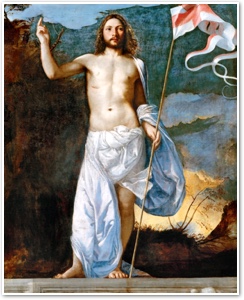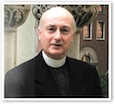Christmas is about two caves
- FATHER GEORGE RUTLER
Saint Paul was converted by the risen Christ, who appeared as a blinding light.
 Later, he would meet Peter and James who had seen the actual risen body, which had changed from the way it appeared during Christ's three years with them.
Later, he would meet Peter and James who had seen the actual risen body, which had changed from the way it appeared during Christ's three years with them.
The body of the resurrected Christ had four characteristics. First, it could no longer feel pain. This "impassibility" was a triumph over the horrors of the Passion. Second, by "subtlety" the body was no longer subject to the laws of physics. During his earthly life, Christ had to knock on doors to enter, but in the Resurrection, he could appear in a room though the doors were locked. Third, the "agility" of Christ's body had a strength that freed him from the constraints of motion and enabled him to bi-locate. Fourth, the "clarity" of the risen body radiated a brilliance that emanated from the divine intelligence: "light from light." This was glimpsed in the Transfiguration, and was what blinded Paul on the Damascus road.
These lines would seem to be an Easter meditation, but they are a Christmas meditation as well, for the two mysteries are inseparable. Without the Resurrection, the Nativity would be just another birthday, for even extraordinary people like Alexander the Great or Mozart had ordinary births. Because Christ is the Divine Word who created all things, the restrictions of his human nature are no less wonderful than the glory of his divine nature.
The infant in Bethlehem was not impassible: he hungered and cried like any other baby. Without subtlety, he was confined to the stable. While in the Resurrection his agility could cast aside the shroud, in the manger he was bound by swaddling clothes. And as for clarity, his infant body could be glimpsed in the darkness only by frail lamplight. As he has no beginning and no end, his divine glory was not something he attained as he grew up: rather, it was what he allowed to dim when he came into time and space. He "emptied himself, taking the form of a bond-servant, and being made in the likeness of men" (Philippians 2:7).
So Christmas is about two caves, and the birth in a stone stable would be only a sentimental reverie without the fact of the burial cave burst open. The Holy Infant in the manger is a kind of graphic hint for our limited intelligence, of the indescribable Ruler and Judge of the Universe. And the qualities of his risen body intimated what he would let us become in eternity.
That youngest of the apostles wrote in his old age: "Beloved, now we are children of God, and it has not appeared as yet what we will be. We know that when he appears, we will be like him, because we will see him just as he is" (1 John 3:2).
 This is Meaghen Gonzalez, Editor of CERC. I hope you appreciated this piece. We curate these articles especially for believers like you.
This is Meaghen Gonzalez, Editor of CERC. I hope you appreciated this piece. We curate these articles especially for believers like you.
Please show your appreciation by making a $3 donation. CERC is entirely reader supported.

Acknowledgement
 Father George W. Rutler. "Christmas is about two caves." From the Pastor (December 24, 2017).
Father George W. Rutler. "Christmas is about two caves." From the Pastor (December 24, 2017).
Reprinted with permission from Father George W. Rutler.
The Author
 Father George W. Rutler is the pastor of St. Michael's church in New York City. He has written many books, including: The Wit and Wisdom of Father George Rutler, The Stories of Hymns, Hints of Heaven: The Parables of Christ and What They Mean for You, Principalities and Powers: Spiritual Combat 1942-1943, Cloud of Witnesses — Dead People I Knew When They Were Alive, Coincidentally: Unserious Reflections on Trivial Connections, A Crisis of Saints: Essays on People and Principles, Brightest and Best, and Adam Danced: The Cross and the Seven Deadly Sins.
Father George W. Rutler is the pastor of St. Michael's church in New York City. He has written many books, including: The Wit and Wisdom of Father George Rutler, The Stories of Hymns, Hints of Heaven: The Parables of Christ and What They Mean for You, Principalities and Powers: Spiritual Combat 1942-1943, Cloud of Witnesses — Dead People I Knew When They Were Alive, Coincidentally: Unserious Reflections on Trivial Connections, A Crisis of Saints: Essays on People and Principles, Brightest and Best, and Adam Danced: The Cross and the Seven Deadly Sins.




